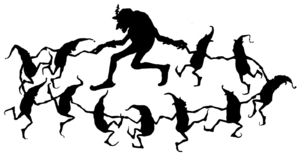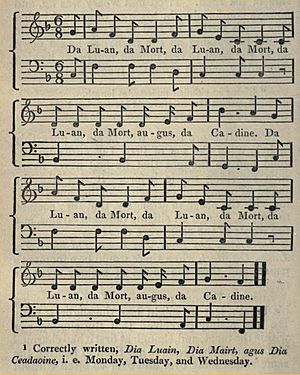The Legend of Knockgrafton facts for kids

"The Legend of Knockgrafton" is a famous folk tale from Ireland. It was first written down by T. Crofton Croker in his book Fairy Legends and Traditions of the South of Ireland in 1825. This story is about two men with humps on their backs and how they meet magical fairies. One man, Lusmore, makes the fairies happy and gets a wonderful reward. The other man, Jack Madden, makes them angry and gets a surprising punishment!
Contents
The Story of Lusmore and Jack Madden
The tale was first shared in Thomas Crofton Croker's book Fairy Legends and Traditions of the South of Ireland in 1825. Here's what happens in the story:
There once was a man with a hump on his back. He earned his living by selling things he wove from straw or rushes. People called him Lusmore. This nickname came from the Irish words lus mór, meaning "great herb" or "foxglove." He always wore a sprig of this plant on his straw hat. Lusmore lived in the beautiful Glen of Aherlow in County Tipperary.
One day, after selling his goods, Lusmore felt tired. He decided to rest near a special mound of earth called the moat of Knockgrafton. As it got dark, he heard voices singing from inside the mound. It was the fairies! They were singing a simple song: "Da Luan, Da Mort" (which means "Monday, Tuesday" in Irish).
When the fairies paused their song, Lusmore, being a cheerful person, sang back. He added "agus Da Cadine" (meaning "and Wednesday") to their tune. The fairies loved this! They were so delighted that a whirlwind picked Lusmore up and carried him inside their magical mound. There, he was entertained with music and fun. As a reward for his clever addition to their song, the fairies removed his hump! They also gave him a brand new set of fine clothes.
Later, an old woman from County Waterford came to visit. She had heard Lusmore's amazing story and wanted to know all the details. She had a hunchbacked godson named Jack Madden. Jack wanted to have his hump removed too, just like Lusmore. So, Jack traveled to the same moat to try and get the same reward.
But Jack was impatient and a bit greedy. He interrupted the fairies' song. Instead of just adding one day, he added two more: "Da Dardine, augus Da Hena" (meaning "Thursday and Friday"). He hoped to get even more rewards, maybe even double the clothes! However, this only made the fairies angry. As punishment, twenty strong fairies brought Lusmore's old hump and placed it right on top of Jack's original hump! Poor Jack Madden later died from sadness and shame.
The Fairy Song
When T. Crofton Croker first wrote down this story, he also included the music for the "Da Luan, Da Mort" song. He said that storytellers often sang this tune when they told the tale.
Where the Story Takes Place
The "Moat of Knockgrafton" is a special place in the story. It's often described as a barrow or a tumulus (an ancient burial mound). However, some people say it's actually a rath or an old fort. It's usually identified as Knockgraffon in County Tipperary. This spot is about three miles north of Cahir, which is the town where Lusmore sold his goods.
At the beginning of the story, Lusmore lives in the Glen of Aherlow, which is at the foot of the Galtee Mountains. This area is west of Knockgraffon. Later in the story, Lusmore's village is called "Cappagh."
Patrick Weston Joyce, a writer who studied Irish places, said that in the south of Ireland, a mound where fairy music is heard is called a lissakeole. This means "fort of music" in Irish.
Yeats and the Fairies
The famous Irish poet William Butler Yeats included "The Legend of Knockgrafton" in his collection of stories in 1888.
Yeats was very interested in fairies. Many people who study his work say that he truly believed in them. One writer, Frank Kinahan, said that while other Irish writers saw fairies as dangerous because they were not real, Yeats saw them as dangerous because they were real!
Yeats even claimed that he had personal experiences of being carried away by fairies. He also noted that Irish country folk were genuinely afraid of whirlwinds, believing them to be connected to fairies.
Similar Stories Around the World
It's interesting to know that stories like "The Legend of Knockgrafton" exist in many other places!
The famous Grimm Brothers from Germany translated this Irish tale as "Fingerhütchen" (meaning 'Little foxglove'). In their own collection of fairy tales, they mentioned other stories from different countries that are similar. One example is a story from Brittany (a region in France) called "Les korils de Plauden." The koril are a type of fairy in Brittany.
An Asian Connection
One of the most surprising parallels is with a Japanese folk tale called Kobutori Jiisan, which means "Old Man with a Wen." A wen is a type of lump or growth. In this Japanese story, an old man with a wen on his face meets goblins (called oni) who remove his wen because he entertains them. Then, another old man with a wen tries to copy him but ends up with the first man's wen added to his own! This is very similar to the story of Lusmore and Jack Madden.
Many people, including the writer Joseph Jacobs, noticed this amazing similarity. It shows how stories can travel and change across different cultures and continents!


